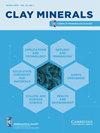Effective removal of hexavalent chromium with magnetically reduced graphene oxide bentonite
IF 1.9
4区 地球科学
Q4 CHEMISTRY, PHYSICAL
引用次数: 2
Abstract
Abstract Water pollution by hexavalent chromium (Cr(VI)) is widespread and problematic. As a result, more research into economic Cr(VI) removal is needed. In this study, we created and employed an adsorption–reduction mechanism to remove Cr(VI). Magnetically reduced graphene oxide bentonite (MrGO-BT) is acid resistant and can undergo magnetic separation. The hydroxyl group of chitosan (CS) condensed with the functional groups on the surface of bentonite (BT), and the MrGO-BT sandwich has been fabricated and constructed from an Fe3O4 core layer sandwiched by reduced graphene oxide (rGO) and a BT shell, with CS acting as a crosslinker. Cr(VI) elimination by MrGO-BT was exothermic and spontaneous according to thermodynamic analyses. The adsorption kinetics and adsorption isotherms were characterized by the pseudo-second order kinetic theory and the Langmuir model, respectively. Regarding the elimination of Cr(VI), the greatest adsorption ability for Cr(VI) elimination achieved was 91.5 mg g–1. Fourier-transform infrared spectroscopy and X-ray photoelectron spectroscopy suggested that Cr(VI) was reduced by C–O–H on MrGO-BT to produce Cr(III) and H–C=O, and that Cr(III) chelated with amino groups or exchanged with BT after intercalation. In addition, the introduction of Cu2+ increased the positive charge of MrGO-BT and amplified the electrostatic interaction between Cr2O72− and HCrO4–, which is what caused Cr(VI) to be eliminated. Cu2+ and reduced Cr(III) combined with -NH2 on the surface of MrGO-BT to form -NH-Cr(III) or -NH-Cu2+, and Cr(VI) elimination via chelation and ion exchange was confirmed. MrGO-BT is shown to be an adsorbent with high acid resistance and good magnetic responsiveness and stability.磁还原氧化石墨烯膨润土有效去除六价铬
摘要六价铬(Cr(VI))对水的污染是普遍存在的问题。因此,需要对经济去除Cr(VI)进行更多的研究。在本研究中,我们创建并采用了吸附-还原机制来去除Cr(VI)。磁性还原氧化石墨烯膨润土(MrGO BT)具有耐酸性,可以进行磁性分离。壳聚糖(CS)的羟基与膨润土(BT)表面的官能团缩合,由还原氧化石墨烯(rGO)夹在Fe3O4芯层和BT壳之间,CS作为交联剂,制备并构建了MrGO-BT三明治。根据热力学分析,MrGO BT对Cr(VI)的消除是放热和自发的。分别用拟二阶动力学理论和Langmuir模型对吸附动力学和吸附等温线进行了表征。关于Cr(VI)的去除,实现的Cr(Ⅵ)去除的最大吸附能力为91.5 mg g–1。傅立叶变换红外光谱和X射线光电子能谱表明,Cr(VI)在MrGO-BT上被C–O–H还原,产生Cr(III)和H–C=O,并且Cr(Ⅲ)在嵌入后与氨基螯合或与BT交换。此外,Cu2+的引入增加了MrGO BT的正电荷,并放大了Cr2O72−和HCrO4–之间的静电相互作用,这就是Cr(VI)被消除的原因。Cu2+和还原的Cr(III)在MrGO-BT表面与-NH2结合形成-NHCr(III)或-NH-Cu2+,并通过螯合和离子交换消除Cr(VI)。MrGO-BT被证明是一种具有高耐酸性和良好磁响应性和稳定性的吸附剂。
本文章由计算机程序翻译,如有差异,请以英文原文为准。
求助全文
约1分钟内获得全文
求助全文
来源期刊

Clay Minerals
地学-矿物学
CiteScore
3.00
自引率
20.00%
发文量
25
审稿时长
6 months
期刊介绍:
Clay Minerals is an international journal of mineral sciences, published four times a year, including research papers about clays, clay minerals and related materials, natural or synthetic. The journal includes papers on Earth processes soil science, geology/mineralogy, chemistry/material science, colloid/surface science, applied science and technology and health/ environment topics. The journal has an international editorial board with members from fifteen countries.
 求助内容:
求助内容: 应助结果提醒方式:
应助结果提醒方式:


